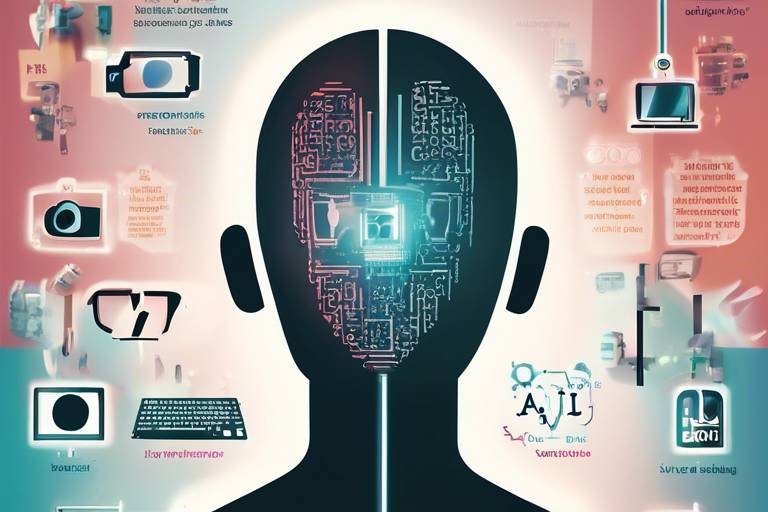Reconciling AI & Ethics in Performance Metrics
In today's rapidly evolving technological landscape, the intersection of artificial intelligence (AI) and ethics in performance metrics is more critical than ever. As businesses increasingly rely on AI-driven evaluations to gauge performance, the ethical implications of these technologies cannot be overlooked. Imagine a world where decisions affecting people's careers, promotions, and even job security are made by algorithms that lack a moral compass. This scenario raises eyebrows and questions about fairness, accountability, and transparency. The challenge lies not only in harnessing the power of AI but also in ensuring that its deployment is guided by ethical principles that benefit both organizations and society at large.
When we talk about ethical AI, we are referring to the need for organizations to implement technology in a manner that is not only effective but also just. This means considering how performance metrics are developed, who they impact, and what biases might be inadvertently encoded into algorithms. The importance of ethical AI becomes clear when we realize that these metrics can significantly influence the trajectory of individuals’ careers and the overall fabric of society. If we fail to address these ethical considerations, we risk perpetuating existing inequalities and creating new forms of discrimination.
As we dig deeper into this subject, it’s essential to recognize the challenges that come with implementing AI in performance metrics. Organizations face a myriad of hurdles, from data bias to a lack of transparency. For instance, data bias can skew the evaluation process, leading to unfair assessments that can be detrimental to employees and organizations alike. The implications of such biases extend beyond individual evaluations; they can affect team dynamics, organizational culture, and even the public perception of a company. Therefore, understanding the types of bias present in AI algorithms is vital for fostering an ethical approach to performance metrics.
Moreover, transparency in AI systems is not just a nice-to-have; it is a necessity. When stakeholders cannot understand how decisions are made, trust erodes. Imagine if you were evaluated by a system you didn’t understand—how would you feel about the feedback or decisions it rendered? This lack of clarity can lead to skepticism and disengagement among employees. Thus, organizations must strive to make their AI systems as transparent as possible, ensuring that performance metrics are not only understandable but also justifiable.
In light of these challenges, the development of regulatory frameworks for ethical AI becomes paramount. These frameworks serve as guiding principles for organizations, promoting accountability and compliance in performance metrics. Various global standards and guidelines have emerged to address the ethical dilemmas posed by AI, helping organizations align their practices with best practices and ethical principles. However, it’s important to note that different industries face unique challenges and regulatory requirements regarding AI ethics. This necessitates tailored approaches to ensure responsible evaluations that respect the nuances of each sector.
Looking toward the future, the relationship between AI and ethics in performance metrics is bound to evolve. As technology continues to advance, so too will societal expectations regarding ethical practices. Ongoing dialogue among stakeholders—business leaders, technologists, ethicists, and the general public—is essential to adapt to these changes. The aim should be to create a landscape where AI not only enhances performance evaluations but does so in a way that is fair, accountable, and transparent.
- What is ethical AI?
Ethical AI refers to the implementation of artificial intelligence technologies in a manner that is fair, accountable, and transparent, ensuring that the impact on stakeholders is considered. - Why is data bias a concern in AI?
Data bias can lead to skewed performance metrics, resulting in unfair evaluations and perpetuating existing inequalities within organizations. - How can organizations ensure transparency in AI?
Organizations can ensure transparency by clearly communicating how AI algorithms work and the criteria used for performance evaluations. - What role do regulatory frameworks play in ethical AI?
Regulatory frameworks provide guidelines for organizations to follow, promoting ethical practices and accountability in AI implementations.

The Importance of Ethical AI
In today's rapidly evolving technological landscape, understanding the significance of ethical AI is more crucial than ever. As organizations increasingly rely on artificial intelligence to drive their performance metrics, the need for ethical considerations becomes paramount. Why? Because the decisions made by AI systems can have profound impacts on individuals and communities. When AI is deployed without a solid ethical framework, it can lead to outcomes that are not only unfair but also damaging to the very stakeholders it aims to serve.
Imagine a world where AI systems evaluate employee performance based on biased data. This could result in certain groups being unfairly judged or overlooked for promotions, perpetuating existing inequalities. The ripple effects of such unfair evaluations extend beyond the workplace, affecting morale, workplace culture, and even the broader community. Thus, ethical AI is not just a buzzword; it is a necessity for fostering fairness, accountability, and transparency in performance metrics.
Moreover, ethical AI practices help organizations build trust with their employees and customers. When stakeholders feel confident that AI systems are operating fairly and transparently, they are more likely to engage with and support the organization. This trust is essential for long-term success, as it can lead to increased loyalty, better performance, and a positive public image.
To further illustrate this point, consider the following key aspects of ethical AI:
- Fairness: Ensuring that AI systems do not discriminate against any group based on race, gender, or socioeconomic status.
- Accountability: Organizations must be held responsible for the outcomes of their AI systems, ensuring that there are mechanisms in place to address any negative consequences.
- Transparency: Stakeholders should have access to information about how AI systems make decisions, allowing them to understand and challenge these processes if necessary.
As we delve deeper into the realm of AI, we must remember that technology is a tool, and like any tool, its impact depends on how we wield it. By prioritizing ethical considerations in AI, organizations can not only improve their performance metrics but also contribute to a more just and equitable society. The journey toward ethical AI is ongoing, and it requires constant vigilance, open dialogue, and a commitment to doing what is right.

Challenges in AI Implementation
Implementing artificial intelligence (AI) in performance metrics is akin to navigating a complex maze filled with unexpected twists and turns. While the potential benefits of AI are immense, the journey is fraught with challenges that organizations must confront to harness its full power. One of the most pressing issues is the data bias that can skew results and lead to unfair evaluations. Imagine trying to climb a mountain where the path is uneven; every misstep in data handling can lead to a fall from grace in performance assessments.
Moreover, the lack of transparency in AI algorithms poses a significant hurdle. When algorithms operate like a black box, shrouded in mystery, it becomes difficult for stakeholders to trust the outcomes. This opacity can lead to ethical dilemmas, as users may question the validity of the metrics being presented. Just like a magician who refuses to reveal their tricks, AI systems that lack transparency can create skepticism and distrust among those affected by their decisions.
Another challenge organizations face is the ethical dilemmas that arise from AI usage. For instance, what happens when an AI system inadvertently perpetuates stereotypes or reinforces existing inequalities? These ethical quandaries can have profound implications, not only for the organization itself but also for the broader society. As we delve deeper into the AI landscape, it becomes increasingly clear that organizations must prioritize ethical considerations in their performance metrics to avoid potential fallout.
To illustrate the challenges in AI implementation, consider the following table that summarizes key issues organizations encounter:
| Challenge | Description |
|---|---|
| Data Bias | Skewed data can lead to unfair evaluations and decisions. |
| Lack of Transparency | Opaque algorithms create distrust among users and stakeholders. |
| Ethical Dilemmas | AI systems may unintentionally reinforce stereotypes or inequalities. |
Organizations must also consider the technical challenges associated with integrating AI into existing systems. This includes compatibility issues, the need for robust infrastructure, and the ongoing requirement for maintenance and updates. The rapid pace of technological advancement means that what works today may not be effective tomorrow, creating a constant need for adaptation.
Ultimately, the path to successful AI implementation in performance metrics requires a multifaceted approach. Organizations must not only address these challenges head-on but also foster a culture of ethical awareness and responsibility. By doing so, they can pave the way for a future where AI serves as a powerful ally in driving performance while upholding the values of fairness, accountability, and transparency.
- What is data bias in AI? Data bias occurs when the data used to train AI systems is skewed, leading to unfair or inaccurate outcomes.
- Why is transparency important in AI? Transparency ensures that stakeholders can understand and trust the AI processes and the metrics derived from them.
- How can organizations mitigate ethical dilemmas in AI? By prioritizing ethical considerations and implementing diverse data sourcing and algorithm audits.

Data Bias and Its Implications
Data bias is a critical issue in the realm of artificial intelligence, especially when it comes to performance metrics. Imagine trying to bake a cake but only using stale ingredients; the outcome would be far from delightful. Similarly, if the data fed into AI systems is biased, the performance metrics derived from it will be skewed, potentially leading to **unfair evaluations** and harmful consequences. This is not just a minor glitch; it can affect hiring decisions, loan approvals, and even law enforcement practices. In a world increasingly driven by AI, understanding and addressing data bias is paramount.
One of the most insidious forms of data bias is **sampling bias**, which occurs when the data collected does not accurately represent the population it aims to reflect. For instance, if an AI system is trained primarily on data from a specific demographic, it may perform exceptionally well for that group but fail miserably for others. This can lead to significant disparities in outcomes, reinforcing existing inequalities. Another type of bias is **confirmation bias**, where algorithms are designed to favor specific outcomes, often due to the way data is interpreted or presented. This can create a feedback loop that perpetuates inaccuracies and unfairness.
To illustrate the implications of data bias, consider a recent study that analyzed the performance metrics of AI recruitment tools. The findings revealed that these tools often favored candidates from certain backgrounds while systematically disadvantaging others. The result? A workforce that lacks diversity and fails to reflect the rich tapestry of society. Such outcomes not only harm individuals but can also stifle innovation and growth within organizations. Hence, identifying and mitigating data bias is not just a technical challenge; it is a **moral imperative** for businesses and society alike.
Organizations must take proactive steps to identify and mitigate bias in their AI systems. This includes implementing robust data collection methods that prioritize **diversity and inclusion**. By sourcing data from a wide range of demographics and experiences, companies can create more equitable AI systems. Additionally, regular **algorithm audits** can help identify potential biases before they manifest in harmful ways. The goal is to ensure that performance metrics reflect a fair and accurate evaluation of all stakeholders involved.
In summary, data bias poses significant risks to the integrity of AI-driven performance metrics. By understanding its implications and actively working to mitigate it, organizations can foster a more equitable and just society. The journey to ethical AI is ongoing, but addressing data bias is a crucial step towards achieving that goal.
- What is data bias? Data bias refers to systematic errors in data collection or processing that lead to unfair or inaccurate outcomes in AI systems.
- How does data bias affect AI performance metrics? Data bias can skew performance metrics, leading to unfair evaluations and perpetuating inequalities.
- What are some strategies to mitigate data bias? Organizations can implement diverse data sourcing, conduct algorithm audits, and promote inclusive data practices to reduce bias.
- Why is transparency important in AI systems? Transparency builds trust among users and stakeholders, ensuring that performance metrics are understandable and justifiable.

Types of Bias in AI
When we dive into the world of artificial intelligence, it’s essential to recognize that not all data is created equal. Just like how a chef needs the right ingredients to whip up a delicious meal, AI systems require high-quality, unbiased data to function correctly. Unfortunately, biases can creep in from various sources, leading to skewed performance metrics that can significantly impact decisions. Let’s break down some of the most common types of bias found in AI.
Sampling Bias is one of the most prevalent forms of bias. Imagine a survey about a new product that only includes responses from a specific demographic group. If the sample doesn’t represent the broader population, the conclusions drawn will be misleading. In AI, if the training data is not diverse enough, the model will learn patterns that do not reflect reality, leading to unfair outcomes.
Another type is Confirmation Bias, which occurs when an AI system is designed or trained to seek out information that confirms existing beliefs while ignoring contradictory evidence. This can happen if the data used to train the model is already biased or if the developers unconsciously favor certain outcomes. As a result, the AI may reinforce stereotypes or perpetuate existing inequalities.
Moreover, there’s Measurement Bias, which arises from the tools and methods used to collect data. For instance, if a performance metric is based on flawed measurements, the AI's conclusions will be inherently flawed as well. This type of bias can distort the evaluation of employee performance or customer satisfaction, leading to misguided strategies.
Lastly, we have Algorithmic Bias. This occurs when the algorithms themselves are biased due to the way they are constructed or the assumptions they make. For example, if an algorithm is designed with certain parameters that favor one group over another, it can lead to discriminatory practices in hiring or lending decisions. The implications of algorithmic bias are particularly concerning, as they can perpetuate systemic inequalities on a larger scale.
In summary, understanding the various types of bias in AI is crucial for organizations aiming to implement ethical AI practices. By recognizing these biases, businesses can take proactive steps to mitigate their effects, ensuring that AI-driven performance metrics are fair, equitable, and reflective of the diverse society we live in.
- What is sampling bias in AI? Sampling bias occurs when the data used to train an AI model is not representative of the broader population, leading to inaccurate conclusions.
- How can organizations mitigate confirmation bias? Organizations can mitigate confirmation bias by ensuring diverse data sources and regularly auditing AI algorithms to identify and correct biases.
- What are the consequences of measurement bias? Measurement bias can lead to flawed performance evaluations and misguided business strategies, affecting overall organizational effectiveness.
- Why is algorithmic bias a concern? Algorithmic bias can perpetuate systemic inequalities and discrimination, making it essential for organizations to scrutinize their algorithms closely.

Strategies to Mitigate Bias
When it comes to mitigating bias in AI systems, organizations must adopt a multifaceted approach that encompasses various strategies. One of the most effective ways to begin is by ensuring diverse data sourcing. This means collecting data from a wide range of demographics and backgrounds to ensure that the AI algorithms are trained on a representative sample. Imagine trying to bake a cake using only one type of flour; it’s unlikely to turn out well. Similarly, a narrow dataset can lead to skewed AI outcomes. By broadening the scope of data collection, organizations can enhance the fairness and accuracy of their performance metrics.
Another crucial strategy involves conducting algorithm audits. Regularly reviewing and testing algorithms can help identify any biases that may have crept in during the development process. This is akin to having a mechanic regularly check your car; it helps ensure everything runs smoothly. Audits should not just be a one-time event but rather an ongoing practice. By continuously scrutinizing algorithms, organizations can make necessary adjustments to uphold ethical standards in AI.
Furthermore, fostering a culture of ethical awareness within the organization is vital. This can be achieved through training programs that educate employees about the ethical implications of AI and the importance of bias mitigation. When team members understand the potential consequences of biased AI, they are more likely to prioritize fairness in their work. Think of it as planting seeds of ethical responsibility that can grow into a robust framework for decision-making.
Collaboration with external experts can also provide valuable insights. Engaging with ethicists, data scientists, and community representatives can help organizations identify blind spots in their AI systems. By bringing diverse perspectives to the table, organizations can make informed decisions that reflect a broader understanding of societal values and ethics.
Lastly, implementing feedback mechanisms allows users and stakeholders to voice their concerns regarding AI performance metrics. This two-way communication can serve as a crucial check on the system, enabling organizations to adjust their algorithms based on real-world experiences and perceptions. Just as a good teacher learns from their students, organizations can learn from the people affected by their AI systems.
In summary, mitigating bias in AI requires a comprehensive strategy that includes diverse data sourcing, regular algorithm audits, fostering ethical awareness, collaborating with experts, and establishing feedback mechanisms. By taking these steps, organizations can work towards creating AI systems that are not only effective but also fair and just.
- What is data bias in AI? Data bias occurs when the data used to train AI models is unbalanced or unrepresentative, leading to skewed outcomes.
- How can organizations ensure fairness in AI? By implementing strategies like diverse data sourcing and algorithm audits, organizations can enhance the fairness of their AI systems.
- Why is transparency important in AI? Transparency builds trust among users and stakeholders, ensuring that performance metrics are understandable and justifiable.
- What role do regulatory frameworks play in ethical AI? Regulatory frameworks guide organizations in implementing ethical practices, promoting accountability and compliance in performance metrics.

Transparency in AI Systems
Transparency in AI systems is not just a buzzword; it’s a fundamental necessity for fostering trust and understanding among users and stakeholders alike. Imagine you’re on a road trip, and your GPS suddenly gives you a route without explaining why it chose that path. You’d likely feel uneasy, right? This analogy holds true for AI algorithms. When performance metrics are derived from complex AI systems, users need clarity on how those decisions are made. Without transparency, the technology can seem like a black box, leaving people in the dark about how their data is being used and how outcomes are determined.
One of the primary benefits of transparency is that it allows organizations to ensure that their AI systems are operating fairly and responsibly. When stakeholders can see the underlying processes and data that inform AI decisions, they are more likely to trust the results. This trust is crucial, especially when performance metrics can influence significant outcomes, such as hiring decisions, loan approvals, or even healthcare diagnoses. If people can understand the rationale behind AI-driven evaluations, they are more likely to accept and support those outcomes.
Moreover, transparency can help organizations identify and rectify biases that may exist within their AI systems. For instance, if an AI tool is used to evaluate employee performance, it’s essential to know which data points are being considered. Are they based on objective criteria, or do they reflect underlying biases? By being open about the data and algorithms used, organizations can foster a culture of accountability and continuous improvement.
To enhance transparency, organizations can adopt several strategies:
- Documenting Algorithms: Keeping detailed records of the algorithms used, including their purpose and methodologies, can help demystify the AI processes.
- Regular Audits: Conducting regular audits of AI systems can ensure that they are functioning as intended and align with ethical standards.
- User Education: Providing training and resources to help users understand AI systems can demystify the technology and build trust.
In summary, transparency in AI systems is essential for ensuring fairness, accountability, and trust in performance metrics. By shedding light on the processes that drive AI decisions, organizations can not only enhance their credibility but also foster a more ethical approach to technology implementation. As the landscape of AI continues to evolve, prioritizing transparency will be key to navigating the complexities of ethical AI practices.
Q: Why is transparency important in AI systems?
A: Transparency is crucial because it builds trust among users and stakeholders, allowing them to understand how decisions are made and ensuring accountability in AI-driven evaluations.
Q: How can organizations improve transparency in their AI systems?
A: Organizations can improve transparency by documenting algorithms, conducting regular audits, and providing user education to help stakeholders understand the technology.
Q: What are the risks of not having transparency in AI?
A: Without transparency, there is a risk of mistrust, potential biases going unchecked, and ethical dilemmas arising from unclear decision-making processes.

Regulatory Frameworks for Ethical AI
As artificial intelligence continues to permeate various sectors, the need for regulatory frameworks that ensure ethical AI practices has become increasingly pressing. These frameworks serve as a roadmap, guiding organizations on how to implement AI responsibly while addressing potential risks associated with its use. The landscape of AI regulation is evolving, with governments and organizations worldwide recognizing the importance of establishing guidelines that promote accountability, transparency, and fairness in AI applications.
One of the critical aspects of these regulatory frameworks is their ability to foster trust among users and stakeholders. When organizations adhere to established guidelines, they not only enhance their credibility but also contribute to a broader societal acceptance of AI technologies. This is particularly vital in sectors such as healthcare, finance, and law enforcement, where the implications of AI-driven decisions can significantly impact individuals' lives. For instance, a transparent regulatory framework can help ensure that AI systems used in hiring processes do not inadvertently perpetuate biases, thus promoting a more equitable hiring landscape.
Moreover, the development of these frameworks often involves collaboration between various stakeholders, including governments, industry leaders, and civil society. This collaborative approach is essential to address the multifaceted challenges of AI ethics, as it brings together diverse perspectives and expertise. For example, the European Union has taken significant strides in this area with its AI Act, which aims to regulate high-risk AI applications by setting strict requirements for transparency and accountability. Such initiatives not only help mitigate risks but also encourage innovation by providing clear guidelines for organizations to follow.
To illustrate the importance of regulatory frameworks, consider the following table that highlights key components often found in ethical AI regulations:
| Component | Description |
|---|---|
| Accountability | Ensuring that organizations are responsible for the outcomes of their AI systems. |
| Transparency | Making AI algorithms and their decision-making processes understandable to users. |
| Fairness | Implementing measures to prevent discrimination and bias in AI applications. |
| Data Privacy | Protecting individuals' personal information and ensuring data is used ethically. |
| Compliance | Establishing mechanisms for organizations to adhere to regulations and guidelines. |
In addition to global standards, it is essential to recognize that different industries face unique challenges and regulatory requirements regarding AI ethics. For instance, the healthcare sector may prioritize patient safety and data privacy, while the finance industry might focus on fraud detection and risk management. Tailoring regulatory approaches to these specific contexts is crucial for ensuring that performance metric evaluations are not only responsible but also relevant to the industry in question.
As we look to the future, the dialogue surrounding AI and ethics will continue to evolve. Organizations must remain adaptable and proactive in navigating this complex landscape. By embracing regulatory frameworks and fostering an ethical culture within their operations, businesses can not only safeguard their interests but also contribute to the responsible development of AI technologies that benefit society as a whole.
- What is the purpose of regulatory frameworks for ethical AI?
The primary purpose is to ensure that AI technologies are implemented responsibly, promoting accountability, transparency, and fairness while minimizing risks associated with their use.
- How can organizations ensure compliance with AI regulations?
Organizations can ensure compliance by staying informed about relevant regulations, conducting regular audits, and integrating ethical considerations into their AI development processes.
- What role do stakeholders play in developing regulatory frameworks?
Stakeholders, including governments, industry leaders, and civil society, collaborate to create comprehensive guidelines that address the diverse challenges of AI ethics.

Global Standards and Guidelines
As we venture further into the realm of artificial intelligence, the establishment of has become paramount. These frameworks serve as a compass, guiding organizations toward the ethical implementation of AI technologies. The significance of these standards cannot be overstated, as they not only promote responsible practices but also foster trust among users and stakeholders. Imagine navigating a vast ocean without a map; that's what implementing AI without these guidelines feels like.
One of the most recognized frameworks is the IEEE Ethically Aligned Design initiative, which encourages organizations to consider ethical implications in their AI designs. This guideline emphasizes the importance of human well-being and advocates for transparency, accountability, and fairness in AI systems. Similarly, the ISO/IEC JTC 1/SC 42 committee is dedicated to developing international standards for AI, focusing on topics such as governance and risk management. These standards provide a foundation for organizations to build upon, ensuring that their AI practices are not only effective but also ethical.
Moreover, various governmental and non-governmental organizations have also introduced guidelines that address ethical AI practices. For instance, the European Union's AI Act aims to regulate AI implementations across member states, ensuring that AI technologies are developed and used in a manner that respects fundamental rights. This act categorizes AI applications based on risk levels, which necessitates different compliance requirements. Such regulations are crucial in preventing misuse and ensuring that AI serves the greater good.
Organizations must not only adopt these global standards but also tailor them to fit their specific contexts. Different industries face unique challenges and ethical dilemmas, which require a nuanced approach. For instance, the healthcare sector may prioritize patient privacy and data security, while the financial industry might focus on preventing discrimination in loan approvals. By aligning their performance metrics with these tailored guidelines, organizations can better navigate the complexities of AI ethics.
In conclusion, the development and adherence to global standards and guidelines for ethical AI are essential for fostering a responsible AI ecosystem. These frameworks not only help organizations align their practices with ethical principles but also promote a culture of accountability and trust. As we continue to innovate and integrate AI into various sectors, the importance of these standards will only grow, making it imperative for organizations to stay informed and compliant.
- What are global standards for AI? Global standards for AI are frameworks and guidelines established to ensure ethical practices in the development and implementation of AI technologies.
- Why are ethical guidelines important in AI? Ethical guidelines are crucial as they help prevent misuse of AI technologies, promote fairness, transparency, and accountability, and build trust among users.
- How do industry-specific regulations affect AI? Industry-specific regulations address unique challenges and ethical considerations within each sector, ensuring that AI applications are responsible and aligned with best practices.
- What role does the EU AI Act play in ethical AI? The EU AI Act serves as a regulatory framework that categorizes AI applications based on risk levels and sets compliance requirements to protect fundamental rights.

Industry-Specific Regulations
In the rapidly evolving landscape of artificial intelligence, play a pivotal role in ensuring that ethical considerations are not just an afterthought but a fundamental aspect of performance metrics. Different sectors, such as healthcare, finance, and technology, face unique challenges that necessitate tailored approaches to AI ethics. For instance, in the healthcare industry, AI systems are increasingly being used to assist in diagnosis and treatment recommendations. Here, the stakes are incredibly high, as any bias or error in the performance metrics could lead to severe consequences for patient care and safety.
Similarly, the financial sector is heavily regulated due to the sensitive nature of the data involved. AI algorithms that analyze credit scores or loan applications must adhere to strict guidelines to prevent discrimination and ensure fairness. Organizations must navigate a complex web of regulations that vary not only by country but also by region. This complexity can often lead to confusion, making it essential for businesses to stay informed about the latest developments in AI regulations.
Moreover, the tech industry, which is often at the forefront of AI innovation, faces its own set of challenges. With the rise of data privacy concerns, regulations such as the General Data Protection Regulation (GDPR) in Europe set stringent requirements for how data is collected, used, and stored. Companies must implement robust compliance measures to avoid hefty fines and reputational damage. As AI continues to permeate various sectors, the need for clear and effective regulations becomes increasingly apparent.
To illustrate the diverse regulatory landscape, consider the following table that outlines key regulations across different industries:
| Industry | Key Regulations | Focus Areas |
|---|---|---|
| Healthcare | HIPAA, FDA Guidelines | Patient Privacy, Safety |
| Finance | Equal Credit Opportunity Act, GDPR | Fair Lending, Data Protection |
| Technology | GDPR, CCPA | Data Privacy, User Consent |
As we look to the future, it’s clear that the relationship between AI and industry-specific regulations will continue to evolve. Organizations must remain vigilant, adapting their practices to comply with new laws and guidelines while also fostering a culture of ethical responsibility. This not only protects stakeholders but also enhances the trust and credibility of AI systems. The dialogue surrounding AI ethics is ongoing, and businesses must be proactive in engaging with regulators and industry leaders to shape a framework that promotes fairness and accountability in performance metrics.
In conclusion, understanding and adhering to industry-specific regulations is not just a legal obligation but a moral imperative. As AI technologies become more integrated into various sectors, the need for ethical frameworks that guide their use will only grow stronger. Organizations that prioritize ethical AI practices will not only safeguard their operations but also contribute positively to society as a whole.
- What are industry-specific regulations in AI? Industry-specific regulations in AI are guidelines and laws tailored to address the unique challenges and ethical considerations faced by different sectors, such as healthcare and finance.
- Why are these regulations important? They are essential for ensuring fairness, accountability, and transparency in AI applications, which can significantly impact stakeholders and society.
- How can organizations stay compliant with these regulations? Organizations can stay compliant by regularly reviewing regulatory updates, implementing robust compliance measures, and engaging with industry leaders and regulators.

The Future of AI and Ethics
As we look towards the future, the relationship between artificial intelligence (AI) and ethics in performance metrics is set to undergo significant transformations. The rapid advancement of AI technologies brings with it a wave of opportunities and challenges that demand our attention. So, what does this future hold? Well, it's a bit like navigating a ship through uncharted waters—exciting yet fraught with potential hazards.
One of the most pressing aspects we must consider is the **growing demand for accountability** in AI systems. As businesses increasingly rely on AI to make critical decisions, stakeholders—ranging from consumers to employees—are demanding greater transparency in how these systems operate. Imagine a world where every decision made by AI is as clear as day, where organizations can explain how their algorithms arrived at a conclusion. This level of transparency is not just a nice-to-have; it's becoming a necessity.
Moreover, the ethical implications of AI will likely lead to the establishment of more robust regulatory frameworks. Governments and organizations worldwide are beginning to recognize the need for guidelines that ensure AI technologies are developed and deployed responsibly. This means we will see a rise in global standards that dictate how performance metrics should be designed, implemented, and audited. For instance, consider the potential impact of regulations that require regular audits of AI systems to check for biases and inaccuracies. Such measures could significantly enhance the integrity of performance evaluations.
However, it’s not just about regulations. The conversation around AI ethics is evolving into a more collaborative effort among various stakeholders, including tech companies, policymakers, and civil society. This collaboration is crucial because it allows for a diversity of perspectives, ensuring that the ethical considerations we adopt are comprehensive and inclusive. Think of it as a roundtable discussion where everyone gets a voice, and the outcome is a more balanced approach to AI ethics.
In addition to regulatory frameworks and collaboration, we can’t overlook the role of technology itself. Innovations like explainable AI (XAI) are emerging as key players in the quest for ethical AI. These technologies aim to make AI systems more understandable to humans, thereby enhancing trust and accountability. For instance, if an AI system makes a hiring decision, XAI can help explain the reasoning behind that decision in a way that is accessible and comprehensible. This could revolutionize how organizations approach performance metrics, making them not just data-driven but also ethically sound.
As we move forward, it’s essential to keep in mind the importance of continuous dialogue and adaptation. The landscape of AI is ever-changing, and what may be considered ethical today could shift as new technologies emerge and societal expectations evolve. Organizations must remain agile, ready to reassess their practices and policies in response to these changes. It’s much like tending to a garden; regular maintenance and adaptation to the seasons are crucial for growth.
In conclusion, the future of AI and ethics in performance metrics is not set in stone. It’s a dynamic interplay of technology, regulation, and collaboration that will shape how we evaluate performance in a world increasingly influenced by AI. By prioritizing ethical considerations, we can ensure that AI serves as a tool for good, benefiting businesses and society as a whole.
- What is the importance of ethics in AI? Ethics in AI ensures fairness, accountability, and transparency, which are essential for building trust among users and stakeholders.
- How can organizations mitigate bias in AI systems? Organizations can mitigate bias by sourcing diverse data, conducting algorithm audits, and implementing regular checks for fairness.
- What role do regulations play in AI ethics? Regulations provide guidelines and standards that help organizations implement ethical AI practices and promote accountability.
- What is explainable AI (XAI)? XAI refers to AI systems designed to be transparent and understandable, helping users comprehend how decisions are made.
Frequently Asked Questions
- What is ethical AI and why is it important?
Ethical AI refers to the development and implementation of artificial intelligence systems that prioritize fairness, accountability, and transparency. It's crucial because it shapes how organizations use technology, ensuring that AI-driven evaluations do not unfairly disadvantage any stakeholders.
- What are the main challenges in implementing AI for performance metrics?
Implementing AI in performance metrics comes with challenges like data bias, lack of transparency, and ethical dilemmas. Organizations must navigate these issues to ensure responsible usage and maintain trust among users and stakeholders.
- How does data bias affect performance metrics?
Data bias can lead to skewed performance metrics, resulting in unfair evaluations. If the data used to train AI systems is biased, the outcomes can perpetuate inequality, making it essential to identify and mitigate these biases for ethical AI practices.
- What types of bias should organizations be aware of?
Organizations should be aware of various types of bias, including sampling bias, which occurs when the data sample is not representative, and confirmation bias, where algorithms favor information that confirms existing beliefs. Both can compromise the integrity of performance metrics.
- What strategies can help mitigate bias in AI systems?
To reduce bias, organizations can adopt strategies such as sourcing diverse data, conducting algorithm audits, and involving multidisciplinary teams in AI development. These approaches enhance the fairness and reliability of performance evaluations.
- Why is transparency important in AI systems?
Transparency in AI algorithms is vital for building trust. When users understand how performance metrics are generated and can see the rationale behind them, it fosters confidence and accountability in the AI systems being used.
- What regulatory frameworks exist for ethical AI?
Various global standards and guidelines have emerged to guide organizations in implementing ethical AI practices. These frameworks promote accountability and compliance in performance metrics, helping businesses align with best practices and ethical principles.
- Are there industry-specific regulations for AI ethics?
Yes, different industries face unique challenges and regulatory requirements regarding AI ethics. Tailored approaches are necessary to ensure responsible evaluations of performance metrics that align with industry standards and societal expectations.
- What does the future hold for AI and ethics in performance metrics?
The relationship between AI and ethics in performance metrics is expected to evolve continuously. Ongoing dialogue and adaptation to new technologies and societal expectations will be essential for ensuring that AI remains a force for good.



















